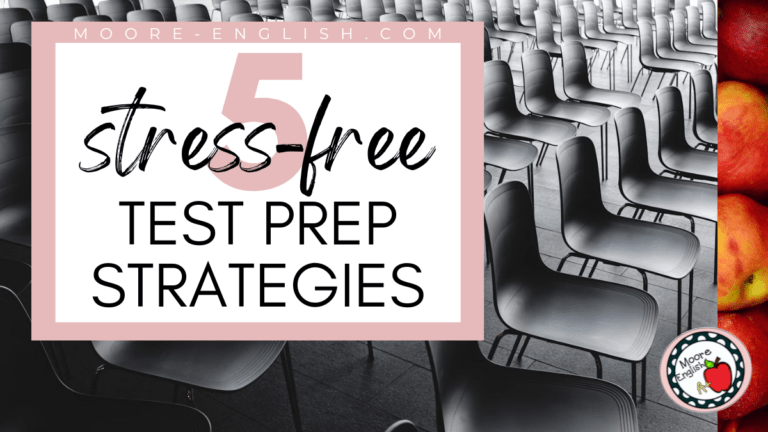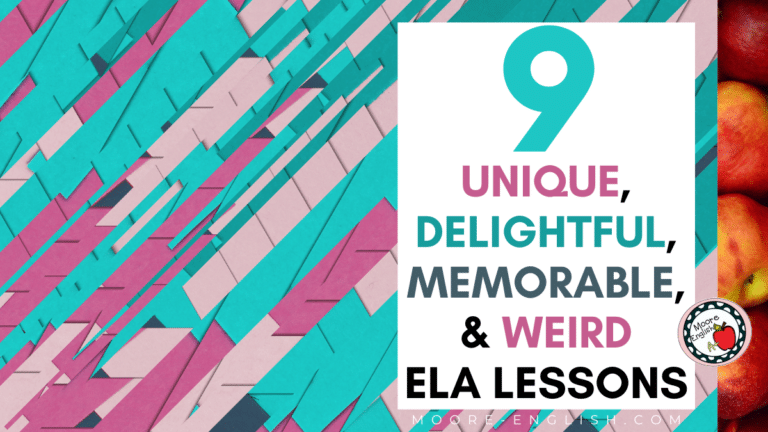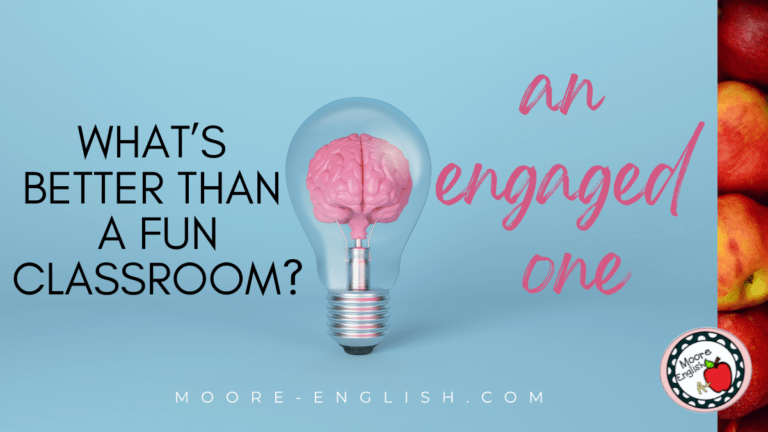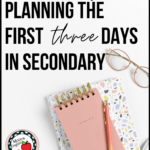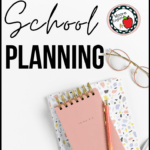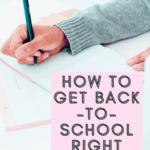My students do not come back to school until the last week of August. This is the latest I have ever started back, but that’s the cost of massive construction across multiple buildings. Even though my students don’t return to school for a few weeks, my mind has been on school since the beginning of August. After some time going back and forth, I think I have figured out the first few days in each of my classes. I wanted to share my ideas with you, and if you have suggestions, I’d love the feedback!
First Day of School
Low-Stress Introductions:
I will meet students at the door. This is a good opportunity to begin learning how to pronounce names and nicknames. After students talk with me, they will go inside and follow directions on the board, which will direct them to find their assigned seats, each of which I have marked with a post-it.
Students will then use their post-its to write down what they like to be called and their pronouns. They will also write one or two interesting facts about themselves. I will use these post-its to take attendance the next few days, and the facts are always so helpful in remembering names! My example post-it will be on the board with big chart paper: My name is Ms. Moore, she/her, and I had really big ears when I was a kid, so my dad calls me “Yoda.”
After the bell rings, students will swap post-its with their elbow partner, and they will introduce one another to the class. That’s all I do for introductions. I like to keep introductions simple and direct so we can move on to more engaging activities.
This post this post may contain affiliate links. Please read the Terms of Use.
Classroom Scavenger Hunt
In the past, I have done stations on the first day of class, but with a change in our schedule this year, I will be doing stations later in the week. Since my school requires teachers give out the syllabus on the first day, I have to address the syllabus in some way. In the past, I have done a Syllabus Scavenger Hunt and Syllabus BINGO, but this year, we’re going to do a Classroom Scavenger Hunt.
To facilitate this, I left some strategic blanks in my syllabus design, so students have to explore the classroom to fill in the blanks. I also added a few extra questions for students to “find” around the room. I use Canva to design my syllabus, and my syllabus template is free here. You can see where I left blanks, and you can see the questions I asked. The last question asks students for their “secret word,” which they can only find my joining our Google Classroom.
Since I have not tried the Classroom Scavenger Hunt before, I’m excited to see how it goes. Ultimately, I chose this activity because it incorporates movement, covers my school’s expectation for sharing the syllabus, and gets every student on Google Classroom on day one.
Second Day of School
Starting to Build Procedures
When my students come in on the second day, I will greet them at the door again. Then, they will come in and start the Bell Work. I am a huge advocate of Bell Work as a meaningful classroom procedure. For the second day of school, the bell work will be this one pager that asks students what things everyone should “note” about them. This is another new idea for me, but I wanted an opportunity for students to share the things I need to know in a safe way. And I wanted an activity that could appeal to verbal or visual learners.
For my freshmen
An important procedure for my students is regular silent reading. About 2-3 times a week, Bell Work is silent reading, usually followed by a journal entry that asks students to apply a concept we have been working on in class (rhetoric, characterization, conflict, etc.) to their reading. For my sophomores and juniors, silent reading will begin in Weeks 2 and 3, but for my freshmen, silent reading begins right away. For this reason, my freshmen will spend the remainder of the class having a book tasting hosted by the school librarians. Since the freshmen are new to the building, this is a great way to expose them to an important part of the school while also putting a book in their hands right away.
For my sophomores
My sophomores enter the class having read To Kill a Mockingbird over the summer. Part of their summer assignment will have been turned in as part of their classroom scavenger hunt, but I also want to help them revisit the novel in a nonthreatening way. For this reason, they will go through some classroom stations with a small group.
- Character Matching: This may seem like a silly station, but enough of my students read the book in May that a quick character matching activity is the perfect way to help them remember everyone. Check out this free activity here.
- Plot Diagram: I use this plot diagram from Danielle Knight to help students re-visit key scenes from the novel. The activity of cutting and pasting also seems to help students internalize the plot events.
- Point of View Worksheet: Most of my students have heard of first, second, and third person by the time they arrive, but they need a refresher, so they work through this activity to remember (or re-learn) some important parts of point of view.
- Goal Setting: I am a big believer in setting and regularly re-visiting classroom goals, so one station always asks students to set their goals for the upcoming year. This is the freebie I use to help students think through their goals. Next week I’m going to share my classroom goals with you!
- Finishing Bell Work
I don’t collect any of these items from the stations. Students put their Goal Setting sheet at the front of their class binders, and the other three items are crucial for tomorrow’s activity.
For my juniors
Like my sophomores, my juniors also come in having finished a summer assignment. Over break, my juniors read The Great Gatsby. Also, like my sophomores, my juniors deserve a chance to revisit East and West Egg before we really dive into the book.
- Plot Diagram: For my juniors, I use this plot diagram from Created for Learning. As with the sophomores, this is a great way to re-activate students’ prior knowledge.
- Goal Setting: Like the sophomores, the juniors will use the same page for goal setting and will also put their goal page at the front of their class binders.
- Grammar Inventory: My juniors tend to come in with a variety of experiences with grammar, so I find a quick Google Form invaluable. Students each complete the form but can still talk about it with their group, and I use the data on day three to get us started with grammar instruction. You can get the free Google Form here; you will be asked to make a copy to add to your Google Drive. There are enough questions on this inventory that it counts as two stations.
- Finishing Bell Work
Third Day of School
Continue Building Procedures
Building procedures takes time, so we will continue working on our Bell Work procedures. For my freshmen, they will read their silent reading books and share their first impressions with their classmates. Students will share their impressions using this quick First Impressions Book Review tool. I like this tool because it provides students clear focus for their writing, and it gives me an idea of where they are writing at right now. It also provides another opportunity for students to interact with one another. And it exposes students to more great literature options! For my sophomores and juniors, it’s time to set some No Excuse grammar rules, which you can read about here.
For my freshmen
I will get a sense of student writing from their First Impressions Book Review, but in order to get a sense of where students are as readers, I have a school-required diagnostic to give. The combination of the test itself and getting students logged in for the first time will take the rest of the class period.
For my sophomores
We will begin by quickly checking the answers on Character Matching and Point of View from yesterday. This is quick and dirty. Then we turn to the plot diagram and really dig in to the climax of the story. For my money, the climax of the story is when Scout stands in the balcony of the courthouse and sees the world from someone else’s perspective. This is a big moment for Scout because prior to this experience, she struggled with empathy (remember Walter Cunningham Jr.).
It takes my students a long time to nail down that Scout’s position is the specific climax, but it connects so well with the plot diagram and the POV activity from yesterday. By the time my students figure it out, we’re all standing on our chairs and trying to see the classroom from a different perspective. When they get it, light bulbs absolutely explode around the room! After having this realization, students will want to re-visit the end of the POV worksheet, and that will take the rest of the class period.
For my juniors
As with my sophomores, I don’t collect anything from my juniors’ stations. The grammar inventory is a Google Form, so I get that data and use it to frame their No Excuse grammar conversation. Students use their plot diagram to complete the activity that will round out their week. Students will work with groups to design their own Book Covers for The Great Gatsby.
Since symbolism is such an important part of The Great Gatsby, designing Book Covers is a great way for students to visualize the text and communicate their understanding. The activity also gives me a glimpse of their skills with summary and citation. At the end of the week, each group will present their Book Cover, so they will get up and in front of the class quickly. Once all the groups have presented, we will hang out Book Covers around the room and revisit them for the duration of the unit.
Epilogue: Day Four and Beyond
Typing through my plans for the first three days of school has helped me visualize the items I need to put together before the first day of class. All too soon, my freshmen will be diving into The Odyssey, sophomores will be revising literary analysis papers, and juniors will be moving on to “Winter Dreams.”
I hope this sharing process inspired or helped you, too. This is, no doubt, one of my longer blog posts. I would love to know what activities you do on the first day of class with students, and if you have feedback, I’d love to hear it!
Here are some other posts and resources to get you ready for back-to-school!
- Back-to-School Bundle
- ELA Goal Setting Freebie
- Back-to-School Bucket List
- 4 Back-to-School One Pagers
- First Impressions Book Reviews
- High School Writing and Grammar Data Sheets
- Successfully Planning the First Three Days of School
- 3 Ways to Use Letter Writing in Secondary ELA (post here)


Photo by Ivory Mix, the Stock Boutique, Styled Stocked Society, Pixiestock, Haute Stock


